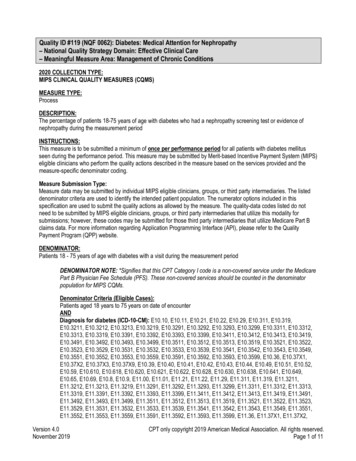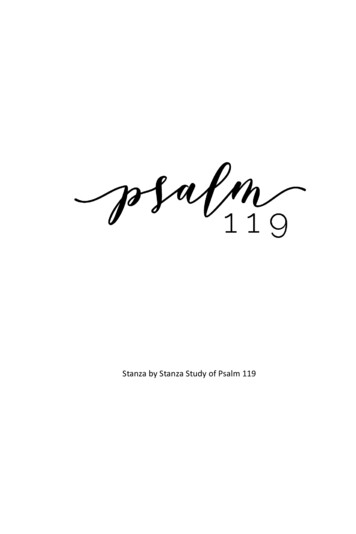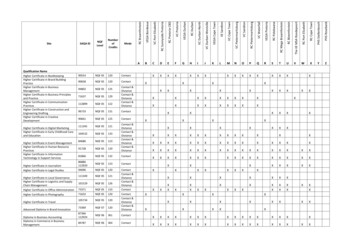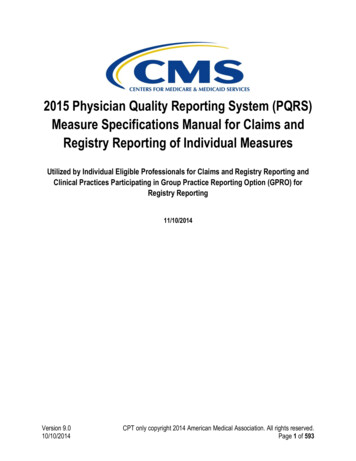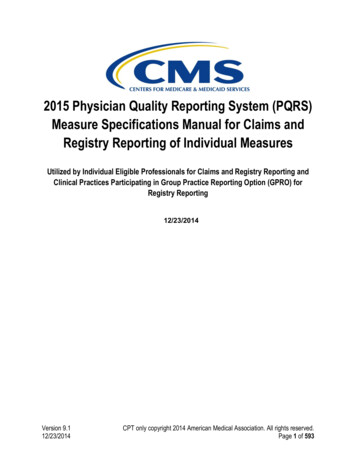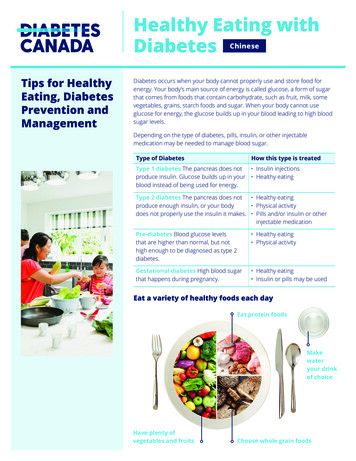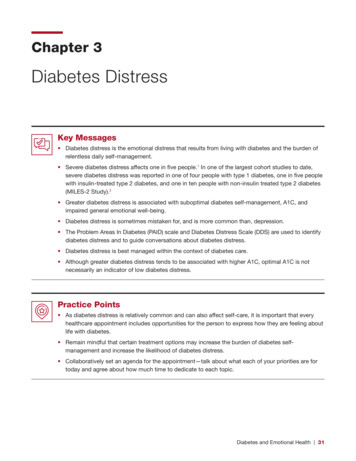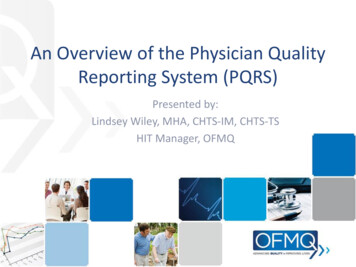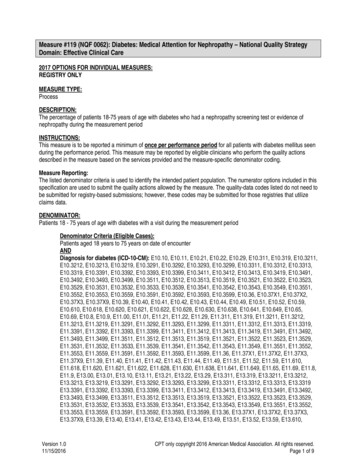
Transcription
Measure #119 (NQF 0062): Diabetes: Medical Attention for Nephropathy – National Quality StrategyDomain: Effective Clinical Care2017 OPTIONS FOR INDIVIDUAL MEASURES:REGISTRY ONLYMEASURE TYPE:ProcessDESCRIPTION:The percentage of patients 18-75 years of age with diabetes who had a nephropathy screening test or evidence ofnephropathy during the measurement periodINSTRUCTIONS:This measure is to be reported a minimum of once per performance period for all patients with diabetes mellitus seenduring the performance period. This measure may be reported by eligible clinicians who perform the quality actionsdescribed in the measure based on the services provided and the measure-specific denominator coding.Measure Reporting:The listed denominator criteria is used to identify the intended patient population. The numerator options included in thisspecification are used to submit the quality actions allowed by the measure. The quality-data codes listed do not need tobe submitted for registry-based submissions; however, these codes may be submitted for those registries that utilizeclaims data.DENOMINATOR:Patients 18 - 75 years of age with diabetes with a visit during the measurement periodDenominator Criteria (Eligible Cases):Patients aged 18 years to 75 years on date of encounterANDDiagnosis for diabetes (ICD-10-CM): E10.10, E10.11, E10.21, E10.22, E10.29, E10.311, E10.319, E10.3211,E10.3212, E10.3213, E10.3219, E10.3291, E10.3292, E10.3293, E10.3299, E10.3311, E10.3312, E10.3313,E10.3319, E10.3391, E10.3392, E10.3393, E10.3399, E10.3411, E10.3412, E10.3413, E10.3419, E10.3491,E10.3492, E10.3493, E10.3499, E10.3511, E10.3512, E10.3513, E10.3519, E10.3521, E10.3522, E10.3523,E10.3529, E10.3531, E10.3532, E10.3533, E10.3539, E10.3541, E10.3542, E10.3543, E10.3549, E10.3551,E10.3552, E10.3553, E10.3559, E10.3591, E10.3592, E10.3593, E10.3599, E10.36, E10.37X1, E10.37X2,E10.37X3, E10.37X9, E10.39, E10.40, E10.41, E10.42, E10.43, E10.44, E10.49, E10.51, E10.52, E10.59,E10.610, E10.618, E10.620, E10.621, E10.622, E10.628, E10.630, E10.638, E10.641, E10.649, E10.65,E10.69, E10.8, E10.9, E11.00, E11.01, E11.21, E11.22, E11.29, E11.311, E11.319, E11.3211, E11.3212,E11.3213, E11.3219, E11.3291, E11.3292, E11.3293, E11.3299, E11.3311, E11.3312, E11.3313, E11.3319,E11.3391, E11.3392, E11.3393, E11.3399, E11.3411, E11.3412, E11.3413, E11.3419, E11.3491, E11.3492,E11.3493, E11.3499, E11.3511, E11.3512, E11.3513, E11.3519, E11.3521, E11.3522, E11.3523, E11.3529,E11.3531, E11.3532, E11.3533, E11.3539, E11.3541, E11.3542, E11.3543, E11.3549, E11.3551, E11.3552,E11.3553, E11.3559, E11.3591, E11.3592, E11.3593, E11.3599, E11.36, E11.37X1, E11.37X2, E11.37X3,E11.37X9, E11.39, E11.40, E11.41, E11.42, E11.43, E11.44, E11.49, E11.51, E11.52, E11.59, E11.610,E11.618, E11.620, E11.621, E11.622, E11.628, E11.630, E11.638, E11.641, E11.649, E11.65, E11.69, E11.8,E11.9, E13.00, E13.01, E13.10, E13.11, E13.21, E13.22, E13.29, E13.311, E13.319, E13.3211, E13.3212,E13.3213, E13.3219, E13.3291, E13.3292, E13.3293, E13.3299, E13.3311, E13.3312, E13.3313, E13.3319E13.3391, E13.3392, E13.3393, E13.3399, E13.3411, E13.3412, E13.3413, E13.3419, E13.3491, E13.3492,E13.3493, E13.3499, E13.3511, E13.3512, E13.3513, E13.3519, E13.3521, E13.3522, E13.3523, E13.3529,E13.3531, E13.3532, E13.3533, E13.3539, E13.3541, E13.3542, E13.3543, E13.3549, E13.3551, E13.3552,E13.3553, E13.3559, E13.3591, E13.3592, E13.3593, E13.3599, E13.36, E13.37X1, E13.37X2, E13.37X3,E13.37X9, E13.39, E13.40, E13.41, E13.42, E13.43, E13.44, E13.49, E13.51, E13.52, E13.59, E13.610,Version 1.011/15/2016CPT only copyright 2016 American Medical Association. All rights reserved.Page 1 of 9
E13.618, E13.620, E13.621, E13.622, E13.628, E13.630, E13.638, E13.641, E13.649, E13.65, E13.69, E13.8,E13.9, O24.011, O24.012, O24.013, O24.019, O24.02, O24.03, O24.111, O24.112, O24.113, O24.119,O24.12, O24.13, O24.311, O24.312, O24.313, O24.319, O24.32, O24.33, O24.811, O24.812, O24.813,O24.819, O24.82, O24.83ANDPatient encounter during the performance period (CPT or HCPCS): 99201, 99202, 99203, 99204, 99205,99212, 99213, 99214, 99215, 99341, 99342, 99343, 99344, 99345, 99347, 99348, 99349, 99350, G0402,G0438, G0439AND NOTDENOMINATOR EXCLUSION:Patients who use hospice services any time during the measurement period: G9715NUMERATOR:Patients with a screening for nephropathy or evidence of nephropathy during the measurement periodNumerator Instructions: This measure is looking for a nephropathy screening test or evidence ofnephropathy.Numerator Options:Performance Met:ORPerformance Met:ORPerformance Met:ORPerformance Met:ORPerformance Met:ORPerformance Not Met:Positive microalbuminuria test result documented andreviewed (3060F)Negative microalbuminuria test result documented andreviewed (3061F)Positive macroalbuminuria test result documented andreviewed (3062F)Documentation of treatment for nephropathy (eg, patientreceiving dialysis, patient being treated for ESRD, CRF,ARF, or renal insufficiency, any visit to a nephrologist)(3066F)Patient receiving angiotensin converting enzyme (ACE)inhibitor or angiotensin receptor blocker (ARB) therapy(G8506)Nephropathy screening was not performed, reason nototherwise specified (3060F or 3061F or 3062F with 8P)RATIONALE:As the seventh leading cause of death in the U.S., diabetes kills approximately 75,000 people a year (CDC FastStats2015). Diabetes is a group of diseases marked by high blood glucose levels, resulting from the body's inability toproduce or use insulin (CDC Statistics 2014, ADA Basics 2013). People with diabetes are at increased risk of serioushealth complications including vision loss, heart disease, stroke, kidney failure, amputation of toes, feet or legs, andpremature death. (CDC Fact Sheet 2014).In 2012, diabetes cost the U.S. an estimated 245 billion: 176 billion in direct medical costs and 69 billion in reducedproductivity. This is a 41 percent increase from the estimated 174 billion spent on diabetes in 2007 (ADA Economic2013).Version 1.011/15/2016CPT only copyright 2016 American Medical Association. All rights reserved.Page 2 of 9
In 2011, diabetes accounted for 44% of new kidney failure cases. In the same year, 49,677 diabetics started treatmentfor kidney failure and 228,924 people of all ages with kidney failure due to diabetes were living on chronic dialysis orwith a kidney transplant (CDC Statistics, 2014).CLINICAL RECOMMENDATION STATEMENTS:American Diabetes Association (2015):Screening- At least once a year, quantitatively assess urinary albumin (eg, urine albuminto-creatinine ratio [UACR]) and estimatedglomerular filtration rate (eGFR) in patients with type 1 diabetes duration of greater than or equal to 5 years and in allpatients with type 2 diabetes. (Level of evidence: B)Treatment- An angiotensin-converting enzyme (ACE) inhibitor or angiotensin receptor blocker (ARB) is not recommended for theprimary prevention of diabetic kidney disease in patients with diabetes who have normal blood pressure and normalUACR ( 30 mg/g). (Level of evidence: B)- Either an ACE inhibitor or ARB is suggested for the treatment of the nonpregnant patient with modestly elevatedurinary albumin excretion (30-299 mg/day) (Level of evidence: C) and is recommended for those with urinary albuminexcretion 300 mg/day. (Level of evidence: A)- When ACE inhibitors, ARBs, or diuretics are used, monitor serum creatinine and potassium levels for the developmentof increased creatinine or changes in potassium. (Level of evidence: E)- Continued monitoring of UACR in patients with albuminuria is reasonable to assess progression of diabetic kidneydisease. (Level of evidence: E)American Association of Clinical Endocrinologists (2015):- Beginning 5 years after diagnosis in patients with type 1 diabetes (if diagnosed before age 30) or at diagnosis inpatients with type 2 diabetes and those with type 1 diabetes diagnosed after age 30, annual assessment of serumcreatinine to determine the estimated glomerular filtration rate (eGFR) and urine albumin excretion rate (AER) should beperformed to identify, stage, and monitor progression of diabetic nephropathy (Grade C; best evidence level 3).- Patients with nephropathy should be counseled regarding the need for optimal glycemic control, blood pressurecontrol, dyslipidemia control, and smoking cessation (Grade B; best evidence level 2).- In addition, they should have routine monitoring of albuminuria, kidney function electrolytes, and lipids (Grade B; bestevidence level 2).- Associated conditions such as anemia and bone and mineral disorders should be assessed as kidney functiondeclines (Grade D; best evidence level 4).- Referral to a nephrologist is recommended well before the need for renal replacement therapy (Grade D; bestevidence level 4).COPYRIGHT:These performance measures were developed and are owned by the National Committee for Quality Assurance("NCQA"). These performance measures are not clinical guidelines and do not establish a standard of medical care.NCQA makes no representations, warranties, or endorsement about the quality of any organization or physician thatuses or reports performance measures and NCQA has no liability to anyone who relies on such measures. NCQA holdsa copyright in this measure and can rescind or alter this measure at any time. Users of the measure shall not have theright to alter, enhance, or otherwise modify the measure and shall not disassemble, recompile, or reverse engineer theVersion 1.011/15/2016CPT only copyright 2016 American Medical Association. All rights reserved.Page 3 of 9
source code or object code relating to the measure. Anyone desiring to use or reproduce the measure withoutmodification for a noncommercial purpose may do so without obtaining any approval from NCQA. All commercial usesmust be approved by NCQA and are subject to a license at the discretion of NCQA. Use by health care providers inconnection with their own practices is not commercial use. A "commercial use" refers to any sale, license, or distributionof a measure for commercial gain, or incorporation of a measure into any product or service that is sold, licensed, ordistributed for commercial gain, even if there is no actual charge for inclusion of the measure. 2004-2016 NationalCommittee for Quality Assurance, all rights reserved.Performance measures developed by NCQA for CMS may look different from the measures solely created and ownedby NCQA.CPT contained in the Measures specifications is copyright 2004-2016 American Medical Association.Version 1.011/15/2016CPT only copyright 2016 American Medical Association. All rights reserved.Page 4 of 9
Version 1.011/15/2016CPT only copyright 2016 American Medical Association. All rights reserved.Page 5 of 9
Version 1.011/15/2016CPT only copyright 2016 American Medical Association. All rights reserved.Page 6 of 9
2017 Registry Individual Measure Flow#119 NQF #0062: Diabetes: Medical Attention for NeuropathyPlease refer to the specific section of the Measure Specification to identify the denominator and numerator informationfor use in reporting this Individual Measure.1. Start with Denominator2. Check Patient Age:a. If Age equal to 18 to 75 years of age on Date of Service equals No during the measurement period, do notinclude in Eligible Patient Population. Stop Processing.b. If Age equal to 18 to 75 years of age on Date of Service equals Yes during the measurement period,proceed to Check Patient Diagnosis.3. Check Patient Diagnosis:a. If Diagnosis of Diabetes as Listed in the Denominator equals No, do not include in Eligible PatientPopulation. Stop Processing.b. If Diagnosis of Diabetes as Listed in the Denominator equals Yes, proceed to Check Encounter Performed.4. Check Encounter Performed:a. If Encounter as Listed in the Denominator equals No, do not include in Eligible Patient Population. StopProcessing.b. If Encounter as Listed in the Denominator equals Yes, proceed to Check Patients Who Use HospiceServices Any Time During the Measurement Period.5. Check Patients Who Use Hospice Services Any Time During the Measurement Period:a. If Patients Who Use Hospice Services Any Time During the Measurement Period No, include in the Eligiblepopulation.b. If Patients Who Use Hospice Services Any Time During the Measurement Period equals Yes, do notinclude in Eligible Patient Population. Stop Processing.6. Denominator Population:a. Denominator population is all Eligible Patients in the denominator. Denominator is represented asDenominator in the Sample Calculation listed at the end of this document. Letter d equals 8 patients in thesample calculation.7. Start Numerator8. Check Positive Microalbuminuria Test Result Documented and Reviewed:a. If Microalbuminuria Test Result Documented and Reviewed equals Yes, include in Data Completeness Metand Performance Met.b. Data Completeness Met and Performance Met letter is represented as Data Completeness andPerformance Rate in the Sample Calculation listed at the end of this document. Letter a1 equals 1 patient inSample Calculation.c. If Microalbuminuria Test Result Documented and Reviewed equals No, proceed to NegativeMicroalbuminuria Test Result Documented and Reviewed.Version 1.011/15/2016CPT only copyright 2016 American Medical Association. All rights reserved.Page 7 of 9
9. Check Negative Microalbuminuria Test Result Documented and Reviewed:a. If Negative Microalbuminuria Test Result Documented and Reviewed equals Yes, include in DataCompleteness Met and Performance Met.b. Data Completeness Met and Performance Met letter is represented as Data Completeness and thePerformance Rate in the Sample Calculation listed at the end of this document. Letter a2 equals 1 patient inthe Sample Calculation.c. If Negative Microalbuminuria Test Result Documented and Reviewed equals No, proceed to PositiveMacroalbuminuria Test Result Documented and Reviewed.10. Check Positive Macroalbuminuria Test Result Documented and Reviewed:a. If Positive Macroalbuminuria Test Result Documented and Reviewed equals Yes, include in DataCompleteness Met and Performance Met.b. Data Completeness Met and Performance Met letter is represented as Data Completeness and thePerformance Rate in the Sample Calculation listed at the end of this document. Letter a3 equals 1 patient inthe Sample Calculation.c. If Positive Macroalbuminuria Test Result Documented and Reviewed equals No, proceed to Documentationof Treatment for Nephropathy.11. Check Documentation of Treatment for Nephropathy:a. If Documentation of Treatment for Nephropathy equals Yes, include in the Data Completeness Met andPerformance Met.b. Data Completeness Met and Performance Met letter is represented as Data Completeness and thePerformance Rate in the Sample Calculation listed at the end of this document. Letter a4 equals 1 patient inthe Sample Calculation.c. If Documentation of Treatment for Nephropathy equals No, proceed to Patient Receiving ACE Inhibitor orARB Therapy.12. Check Patient Receiving ACE Inhibitor or ARB Therapy:a. If Patient Receiving ACE Inhibitor or ARB Therapy equals Yes, include in the Data Completeness Met andPerformance Met.b. Data Completeness Met and Performance Met letter is represented as Data Completeness and thePerformance Rate in the Sample Calculation listed at the end of this document. Letter a5 equals 0 patientsin the Sample Calculation.c. If Patient Receiving ACE Inhibitor or ARB Therapy equals No, proceed to Nephropathy Screening NotPerformed, Reason Not Specified.13. Check Nephropathy Screening Not Performed, Reason Not Specified:a. If Nephropathy Screening Not Performed, Reason Not Specified equals Yes, include in the DataCompleteness Met and Performance Not Met.b. Data Completeness Met and Performance Not Met letter is represented as Data Completeness in theSample Calculation listed at the end of this document. Letter c equals 3 patients in the Sample Calculation.Version 1.011/15/2016CPT only copyright 2016 American Medical Association. All rights reserved.Page 8 of 9
c. If Nephropathy Screening Not Performed, Reason Not Specified equals No, proceed to Data CompletenessNot Met.14. Check Data Completeness Not Met:a. If Data Completeness Not Met equals No, Quality Data Code or equivalent not reported. 1 patient has beensubtracted from the Data Completeness numerator in the sample calculation.Version 1.011/15/2016CPT only copyright 2016 American Medical Association. All rights reserved.Page 9 of 9
2017 Registry Individual Measure Flow #119 NQF #0062: Diabetes: Medical Attention for Neuropathy Please refer to the specific section of the Measure Specification to identify the denominator and numerator information for use in reporting this Individual Measure. 1. Start with Denominator 2. Check Patient Age: a.
